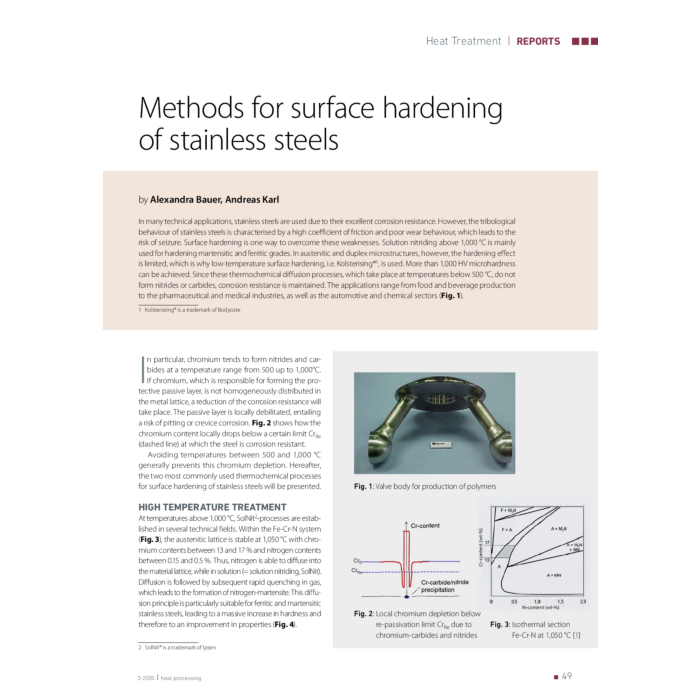Methods for surface hardening of stainless steels
4,90 €
Auf Lager
Artikelnummer
00541_2020_03_04
In many technical applications, stainless steels are used due to their excellent corrosion resistance. However, the tribological behaviour of stainless steels is characterised by a high coefficient of friction and poor wear behaviour, which leads to the risk of seizure. Surface hardening is one way to overcome these weaknesses. Solution nitriding above 1,000 °C is mainly used for hardening martensitic and ferritic grades. In austenitic and duplex microstructures, however, the hardening effect is limited, which is why low-temperature surface hardening, i.e. Kolsterising®, is used. More than 1,000 HV microhardness can be achieved. Since these thermochemical diffusion processes, which take place at temperatures below 500 °C, do not form nitrides or carbides, corrosion resistance is maintained. The applications range from food and beverage production to the pharmaceutical and medical industries, as well as the automotive and chemical sectors (Fig. 1).
| Autoren | Alexandra Bauer, Andreas Karl |
|---|---|
| Erscheinungsdatum | 27.10.2020 |
| Format | |
| Verlag | Vulkan-Verlag GmbH |
| Sprache | English |
| Titel | Methods for surface hardening of stainless steels |
| Beschreibung | In many technical applications, stainless steels are used due to their excellent corrosion resistance. However, the tribological behaviour of stainless steels is characterised by a high coefficient of friction and poor wear behaviour, which leads to the risk of seizure. Surface hardening is one way to overcome these weaknesses. Solution nitriding above 1,000 °C is mainly used for hardening martensitic and ferritic grades. In austenitic and duplex microstructures, however, the hardening effect is limited, which is why low-temperature surface hardening, i.e. Kolsterising®, is used. More than 1,000 HV microhardness can be achieved. Since these thermochemical diffusion processes, which take place at temperatures below 500 °C, do not form nitrides or carbides, corrosion resistance is maintained. The applications range from food and beverage production to the pharmaceutical and medical industries, as well as the automotive and chemical sectors (Fig. 1). |
Eigene Bewertung schreiben


